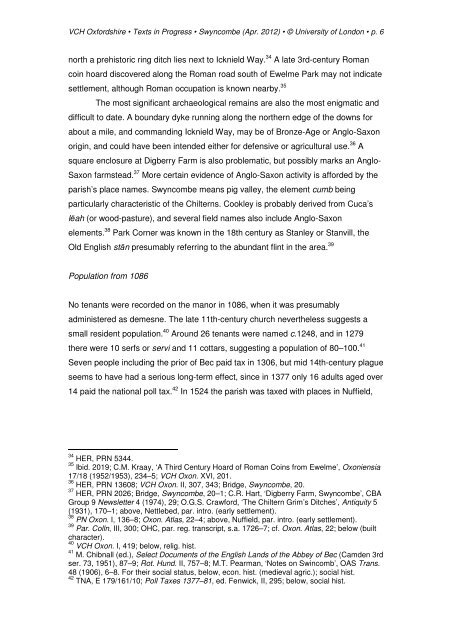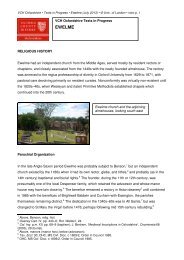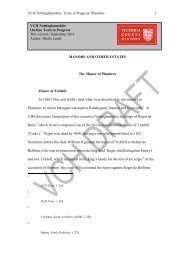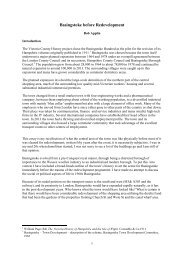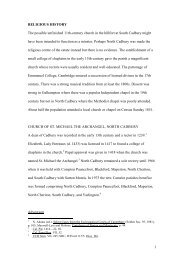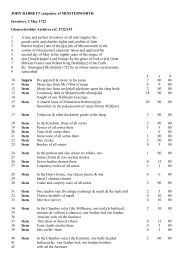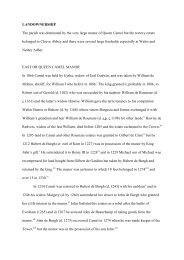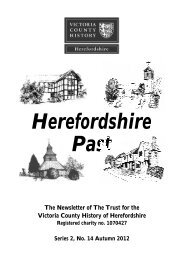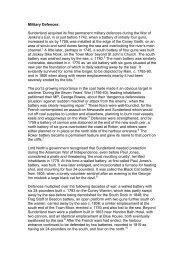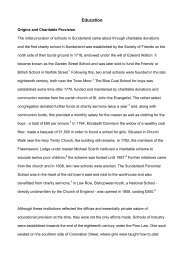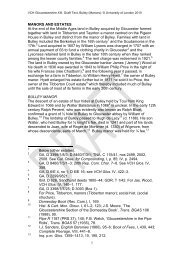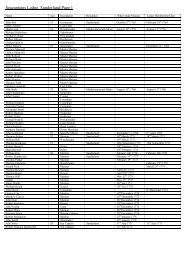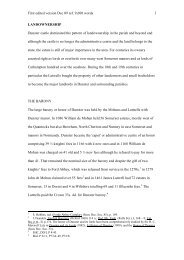Swyncombe intro - Victoria County History
Swyncombe intro - Victoria County History
Swyncombe intro - Victoria County History
Create successful ePaper yourself
Turn your PDF publications into a flip-book with our unique Google optimized e-Paper software.
VCH Oxfordshire • Texts in Progress • <strong>Swyncombe</strong> (Apr. 2012) • © University of London • p. 6<br />
north a prehistoric ring ditch lies next to Icknield Way. 34 A late 3rd-century Roman<br />
coin hoard discovered along the Roman road south of Ewelme Park may not indicate<br />
settlement, although Roman occupation is known nearby. 35<br />
The most significant archaeological remains are also the most enigmatic and<br />
difficult to date. A boundary dyke running along the northern edge of the downs for<br />
about a mile, and commanding Icknield Way, may be of Bronze-Age or Anglo-Saxon<br />
origin, and could have been intended either for defensive or agricultural use. 36 A<br />
square enclosure at Digberry Farm is also problematic, but possibly marks an Anglo-<br />
Saxon farmstead. 37 More certain evidence of Anglo-Saxon activity is afforded by the<br />
parish’s place names. <strong>Swyncombe</strong> means pig valley, the element cumb being<br />
particularly characteristic of the Chilterns. Cookley is probably derived from Cuca’s<br />
lēah (or wood-pasture), and several field names also include Anglo-Saxon<br />
elements. 38 Park Corner was known in the 18th century as Stanley or Stanvill, the<br />
Old English stān presumably referring to the abundant flint in the area. 39<br />
Population from 1086<br />
No tenants were recorded on the manor in 1086, when it was presumably<br />
administered as demesne. The late 11th-century church nevertheless suggests a<br />
small resident population. 40 Around 26 tenants were named c.1248, and in 1279<br />
there were 10 serfs or servi and 11 cottars, suggesting a population of 80–100. 41<br />
Seven people including the prior of Bec paid tax in 1306, but mid 14th-century plague<br />
seems to have had a serious long-term effect, since in 1377 only 16 adults aged over<br />
14 paid the national poll tax. 42 In 1524 the parish was taxed with places in Nuffield,<br />
34 HER, PRN 5344.<br />
35 Ibid. 2019; C.M. Kraay, ‘A Third Century Hoard of Roman Coins from Ewelme’, Oxoniensia<br />
17/18 (1952/1953), 234–5; VCH Oxon. XVI, 201.<br />
36 HER, PRN 13608; VCH Oxon. II, 307, 343; Bridge, <strong>Swyncombe</strong>, 20.<br />
37 HER, PRN 2026; Bridge, <strong>Swyncombe</strong>, 20–1; C.R. Hart, ‘Digberry Farm, <strong>Swyncombe</strong>’, CBA<br />
Group 9 Newsletter 4 (1974), 29; O.G.S. Crawford, ‘The Chiltern Grim’s Ditches’, Antiquity 5<br />
(1931), 170–1; above, Nettlebed, par. <strong>intro</strong>. (early settlement).<br />
38 PN Oxon. I, 136–8; Oxon. Atlas, 22–4; above, Nuffield, par. <strong>intro</strong>. (early settlement).<br />
39 Par. Colln, III, 300; OHC, par. reg. transcript, s.a. 1726–7; cf. Oxon. Atlas, 22; below (built<br />
character).<br />
40 VCH Oxon. I, 419; below, relig. hist.<br />
41 M. Chibnall (ed.), Select Documents of the English Lands of the Abbey of Bec (Camden 3rd<br />
ser. 73, 1951), 87–9; Rot. Hund. II, 757–8; M.T. Pearman, ‘Notes on Swincomb’, OAS Trans.<br />
48 (1906), 6–8. For their social status, below, econ. hist. (medieval agric.); social hist.<br />
42 TNA, E 179/161/10; Poll Taxes 1377–81, ed. Fenwick, II, 295; below, social hist.


